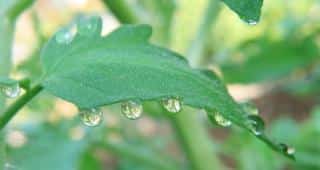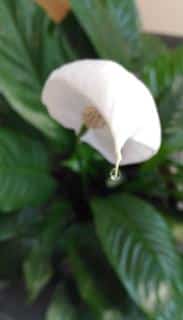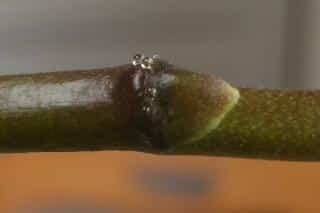

Breakthrough research is analyzing the effect of guttation on the spread of plant diseases. In some cases, guttation is bad for plants. Indeed, when water flows in and out of the plant through thousands of tiny nozzle-like hydathodes on leaves, germs are transported in and out, too.
In itself, guttation is a natural process. It isn’t a disease that the plant catches. A healthy plant guttates from time to time, when conditions trigger it.
However, there are some cases when it isn’t all that good for the plant.
 A study revealed that in greenhouse-grown tomatoes, guttation helped spread bacterial canker responsible for tomato wilt.
A study revealed that in greenhouse-grown tomatoes, guttation helped spread bacterial canker responsible for tomato wilt.
Two lessons were learnt from this:
If any plants in your garden are diseased, wait for guttant drops to dry off before working among them.
In the case of lawn diseases, it usually helps to clear guttation and dew from the grass. This ensures it dries faster. Spores from lawn fungus won’t have time to hatch and contaminate new blades of grass.
Plants know how to counter this, though. It’s been shown that special germ-blocking proteins concentrate around the hydathodes.
 These proteins react with bacteria, fungus and viruses and try to destroy them before they enter further into the plant.
These proteins react with bacteria, fungus and viruses and try to destroy them before they enter further into the plant.
A healthy plant, well fertilized and watered, will produce plenty of these “soldier proteins”. A plant weakened by disease, drought, or neglect will tend to have less of these proteins available.
Reports are discovering that the composition of guttation fluid is strongly influenced by compounds floating in the air.
This is a fascinating inroad into learning about how plants communicate. It may explain why plants not yet diseased or attacked by pests start producing chemical defenses as soon as one of their kind is attacked by pests or illness.
One possible reason that this might work is that water in the guttation fluid forms a permeable barrier that airborn compounds can cross. They dissolve from the air into the guttation and from there gain access to the entire plant’s immune system.
How should guttation influence the way you care for your favorite plants?
 To reduce guttation on houseplants, you can do the following:
To reduce guttation on houseplants, you can do the following:
Indirectly, though, guttation may attract a series of pests. Aphids, scale insects, caterpillars, thrips and many others are attracted by the free source of water and nutrients.
In rare cases, guttation fluid may also stay on the plant for a long time in moist weather; this increases the risk of having sooty mold develop on the plant.
All in all, this is a phenomenon that shouldn’t worry you. And it’s amazing when you see those perfect drops on the tips of leaves and flowers!